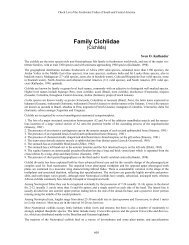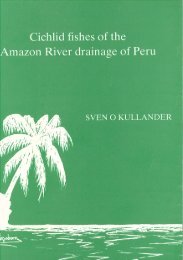Open Access PDF - Sven Kullander
Open Access PDF - Sven Kullander
Open Access PDF - Sven Kullander
Create successful ePaper yourself
Turn your PDF publications into a flip-book with our unique Google optimized e-Paper software.
Fig. 26. Cichla monoculus, freshly captured adult male, not preserved; Brazil: Amazonas: Tefé, Rio Tefé. Photograph<br />
by R. Stawikowski.<br />
Fig. 27. Cichla monoculus, MHNN 2188, 365 mm TL; from the Brazilian collection of Spix and von Martius, but of<br />
doubtful type status. Photograph by M. Kottelat.<br />
Description. Modified from <strong>Kullander</strong> (1986).<br />
Refer to Figs. 24-27 for general shape and colour<br />
pattern, Table 15 for morphometrics, and Tables<br />
2-10 for meristics.<br />
Moderately deep (body depth 28.0-32.5 % SL,<br />
N = 15, 211-344 mm SL). Frontal contour straight<br />
ascending or slightly curved to slightly in advance<br />
of dorsal-fin origin; only a few specimens about<br />
300 mm SL and longer with slight to prominent<br />
(Fig. 26) nuchal protuberance. Maxilla reaching<br />
Ichthyol. Explor. Freshwaters, Vol. 17, No. 4<br />
321<br />
| or middle of orbit. Lower jaw prognathous,<br />
articulation below posterior margin or, in juveniles,<br />
middle of orbit. Lateral line discontinuous<br />
on both sides in all specimens.<br />
Dorsal-fin spines 4-6 longest. Soft dorsal and<br />
anal fins rounded, never extending to caudal-fin<br />
base. Caudal fin in young specimens slightly emarginate,<br />
with squared dorsal and rounded ventral<br />
hind corner, in adults hind margin very slightly<br />
and evenly convex. Pectoral fin acuminate, 4th




